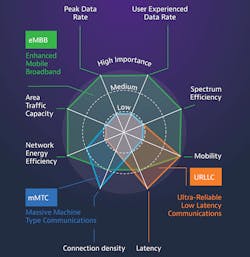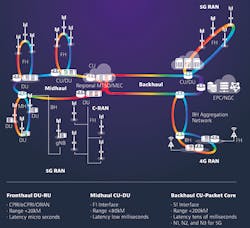Transport Network Leads to the 5G Promise
Midhaul: As Critical as Fronthaul and Backhaul —
5G technology is touted as a platform that enhances our connected world. To deliver on this promise, 5G demands the network supporting it to be as flexible as the services
running on it.
High-Level 5G Use Cases
The following high-level 5G use cases are well understood and documented by the wireless industry.
InvisiLight® Solution for Deploying Fiber
April 2, 2022Go to Market Faster. Speed up Network Deployment
April 2, 2022Episode 10: Fiber Optic Closure Specs Explained…
April 1, 2022Food for Thought from Our 2022 ICT Visionaries
April 1, 2022Enhanced Mobile Broadband (eMBB) — providing greater data-bandwidth services with peak data rates of 10 Gbps and beyond. This data rate enables new use cases such as augmented reality/virtual reality or ultra-high density (UltraHD) applications.
Ultra-Reliable Low Latency Communications (URLLC) — providing ultra-reliable capabilities with availabilities in the range of 99.9999%, and extremely low latency features in millisecond range. Vehicle-to-vehicle communication over 5G networks is one prominent use case for this category.
Massive Machine Type Communication (mMTC) — supporting extremely large numbers of devices in the range of hundreds of thousands per square kilometer. Essential for this application class are battery lives up to 10 years.
The big challenge is how to support these use cases on the same network. (See Figure 1.) Much of the trade buzz to date has been centered on 5G-NR (new radio), virtualized core, and mm-Wave spectrum. Receiving far less attention, but equally important as the new radio interface, is the evolution of the transport network connecting 5G nodes that enable the key 5G use cases — simultaneously.
Figure 1. Importance of key capabilities in different usage scenarios. (Source: ITU IMT Vision)
Midhaul Challenges/Opportunities
Today the most widely used technology is based on the common public radio interface (CPRI) protocol. This includes a link in the RAN infrastructure called fronthaul, in contrast to the backhaul that connects the BBUs with the core mobile network.
Centralization enables resource pooling which optimizes resource utilization. Furthermore, the architecture provides some key functions for advanced LTE technology. The ability to coordinate multiple radios from one location is a key enabler for implementing features such as coordinated multipoint (CoMP), which helps increase user bandwidth by aggregating traffic sourced from multiple cells at the user terminal. All of these advantages come with a massive disadvantage for emerging 5G services: inefficient bandwidth.
CPRI’s stringent delay requirement is well-suited for centralization. However, it creates challenges in terms of bandwidth and node flexibility. CPRI provides a dedicated transport protocol specifically designed to transport radio waveforms between the RRU and BBU. CPRI frames expand with increased radio channel bandwidth and the number of antenna elements. However, CPRI is not very efficient in statistical multiplexing, and cannot scale to the demands of 5G, especially for massive MIMO and larger bandwidth increments. The required bandwidth and antennas in a 5G scenario would push the CPRI bandwidth requirements above 100 Gbps. (See Figure 2.)
Figure 2. CPRI Bandwidth as a function of bandwidth and antenna ports.
These bandwidth allocations would be extremely expensive for larger 5G network rollouts. Therefore, it is important to develop an alternative solution that includes an analysis of the key functional elements between a BBU and an RRU. In this examination, CPRI is the key disadvantage of bandwidth inefficiency: it also has a very limited delay budget. In practice, this means that the distance between BBUs and RRUs will be very limited.
The distance between the radio unit and the baseband is determined by the delay budget and the type of transport technology deployed in the fronthaul. Dark fiber is the simplest one allowing for maximum distance. Transport equipment that contains some processing elements reduces the delay budget, sometimes substantially, as with Optical Transport Networking (OTN). As it is often the case, operators must look at the individual use case, and conduct a trade-off analysis to determine the best transport technology. Key inputs in the analysis include the availability of fiber and equipment rooms, as well as the number and locations of radio end-points.
That’s why using Ethernet for fronthaul and midhaul is very practical. It is backwards-compatible, which allows for commodity equipment, enabling greater convergence of access networks, and enabling statistical multiplexing which helps lower the aggregate bit-rate requirements. Use of standard IP/Ethernet network switching/routing also makes functional virtualization and overall network orchestration relatively easy.
To summarize, splitting the BBU function is essential for 5G services because CPRI is not scalable for eMBB and massive MIMO, and it does not offer the flexibility required for MMTC and uRLLC applications. Moving some of the BBU functions to reduce the fronthaul bit rate (CPRI bit rate is proportional to the number of antenna to user throughput) can impact the latency requirements for coordination features and real-time applications, including uRLLC.
By using network function virtualization (NFV) and flexible split options for different application types, a more optimal midhaul and fronthaul (also known as x-haul) can be implemented. (See Figure 3.)This new x-haul architecture allows for scalable, packet-based transport technologies — but the downside is operators now have to address timing and synchronization issues. Thankfully, those can be addressed using standards-based timing and synchronization technologies such as GPS, PTP, synchronous Ethernet, or something similar.
Figure 3. X-haul evolution
The bottom line is that 5G front-haul and midhaul networks will vary based on the applications offered, network topology, medium availability (fiber, microwave, etc.), and service provider business case. There is no one-size-fits-all.
Testing the Transport Network for 5G
Whether service providers are deploying a new technology or launching a greenfield network, all components, connections, and the overall network integration, need to be tested. After ensuring all physical layer tests are completed (fiber inspection and certification), it is important to run higher layer tests along with timing and sync to ensure the best return on investment.
Failure to test can cause network launch delays, poor 5G system performance, and excessive, unplanned capital expenditure. Ultimately, neglecting to test can negatively affect the customer experience, cause end-user churn, and hurt the topline.
Service level agreements (SLAs) for midhaul networks are very similar to backhaul, which means testing requirements are similar:
A. Bandwidth Measurement/Committed Information Rate
B. Delay and Jitter
C. Packet or Frame Loss
D. RFC 2544 and Y.1564 Test
SLAs for fronthaul networks grow more stringent as higher capacity and ultra-low latency and reliability services are deployed. We will see the network evolve from dark fiber to a wider WDM expansion, which means WDM testing is needed. Some service providers are in the process of deploying NG-PON already as a future investment.
We anticipate more frequent use of Time Sensitive Networking (TSN) for real-time communication with hard, non-negotiable time boundaries for end-to-end transmission latencies, where devices in the network need to have a common time reference and therefore, need to synchronize their clocks. This means in addition to the tests listed earlier, timing and synchronization tests are also required.
Like this Article?
Subscribe to ISE magazine and start receiving your FREE monthly copy today!
Conclusion
As service providers continue the quest to offer new 5G services that require different levels of quality, they are bound to evolve from a CPRI-based fronthaul approach to a more packet-based split architecture. This architecture can meet their needs because it offers greater flexibility, but it also requires a different testing
approach. Validating latency, timing and sync, and network availability at a scale, calls for test solutions that are efficient and simple.
With the fully-integrated VIAVI portfolio of cloud-enabled instruments and systems, software automation, and services for network testing, performance optimization, and service assurance, operators and their partners gain confidence for smooth network and service roll-outs, sustainable network quality, and an excellent customer experience.
About the Author








